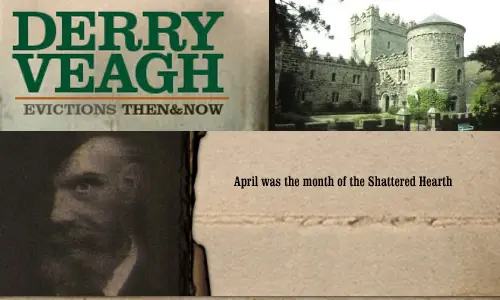In place of this fine population is to-day a deer-forest…
(This from Bernard Barret…)
Memories of a Donegal Tragedy
Its Victims in Australia
“The Earl in Mrs Adair’s Deer Forest”
A few weeks ago, in a fashionable column of a London Daily newspaper, the following paragraph appeared:-
The Earl of Elington has taken Mrs Adair’s deer-forest at Glenveagh, Co. Donegal, for next season.
To many people the existence of a deer-forest in Co. Donegal will come as a surprise; yet it is a fact that a most extensive deer preserve is to be found in the wildest portion of North Donegal, under the shadow of Muckish Mountain.
This portion of Donegal highlands may be said, even in these days of cheap tourist trips, to be the great body of seekers a veritable terra incognito. Access to it is difficult and expensive, and for the cyclist it is oftentimes dangerous, for the roads are appallingly bad, hilly, often precipitous to a degree, and with a surface which must be expected where the Macadam laid on many a night be carried into the valleys by the mountain torrents which find their line of least resistance over the beaten tracks which serve for public roads. But to the adventurous spirit who sets at naught the difficulties of the road and the possibility of having to fall back on the hospitality of the sparse population in the event of his own stock of provisions becoming exhausted, an expedition into the heart of Glenveagh will more than repay the discomfort entailed.
Region’s Wild Beauty
Even the new railway recently opened from Letterkenny to Butonport does nothing to make more accessible the wild beauties of the region, for, apparently for reasons of engineering economies, its course lies on the lower levels leading to Kilmacrenan, Creeslough, &c.;, from any of which stations a desirable start may be made.
What strikes one most in the Glenveagh region is the appalling stillness of the place, the solitude which is almost felt. Far as the eye can see is a panorama of bogs, heather, morass, sterile and inhospitable rocks, and hardly a sign of human life.
Two buildings there are, incongruous and sadly out of place though they seem, suddenly and simultaneously coming on the view of the traveler, to persuade him that the place is not quite beyond the pale of what we are pleased to call modern civilisation. These are the beautiful mansion of Mrs. Adair, known as Glenveagh Castle, and the other is the Royal Irish Constabulary barracks. The latter stands within a stone’s-throw of the entrance to the castle, and looking across the vast wilderness on every hand, no other signs of human habitation can be seen.
Grief and Indignation
Contemplation of the scene is apt to inspire a feeling of awe, which, however, is quickly turned into one of grief and indignation when one learns that less than half a century ago these lonely hills were inhabited by a numerous population, the direct descendants of the faithful clansmen of the ‘Dauntless Red Hugh,’ who, while they eked out a scanty livelihood from the inhospitable land, were yet happy and contented, a fine, stalwart race of brave men and women, who spoke the Gaelic tongue and mixed only among each other, and who, if their thoughts ever did travel beyond the confines of their own beloved mountains, pitied, like the inhabitants of Dr. Johnson’s “Happy Valley,” all those who were excluded from participation in their joys. And the question is at once asked - “How came this desolation and despair and gloom where all was brightness and joy?” The answer is to be found in the history of one of the most dreadful crimes of which a cruel Irish landlordism has ever been convicted even in the worst days of the Land War.
The Sad Story
Going back to the early fifties, many who still live can recall the bright homes of Glenveagh, each with its tract of moorland attached. It is true the tenancy found it difficult to pay the paltry rents levied by the landlords, but the landlords of those days, amongst several of whom this region of Donegal was divided, were of the kind who form the rare exception to the general rule.
As a matter of fact there appears to have existed between these small landlords and their tenantry relations which were not alone cordial, bit to a degree affectionate. And in some measure this devoted loyalty to the landlord whom they had always known was the beginning of the feud which ended in the bodily extirpation of the entire population.
In the year 1857 George Adair, of Bellgrove, Queen’s County, visited Glenveagh on a shooting expedition. He was so struck with the charms of the place that he determined if possible to become its proprietor. This apparently it was not difficult to do, as there were few to make offers for a tract of country which presented so little hope of remunerative return.
Mr. Johnson, one of the owners, promptly parted with his rights, and Mr. Adair entered into his possession. The people, however, resented the transaction, and refused to become the property of a new master. Matters came to a head when they absolutely refused Mr. Adair the right to shoot over their lands. One of the tenants’ leaders was arrested for assault on Mr. Adair, and was finally found not guilty. This man took action against Mr. Adair for assault and malicious prosecution, in which the High Court found a verdict of guilty - but in the lawful exercise of shooting rights! From this forward Mr. Adair entered upon a campaign of repression, alleging all sorts of charges against his tenantry, including sheep-stealing and property destruction of various kinds. Meanwhile he proceeded to purchase other estates until he became absolute owner of nearly a hundred square miles of territory. The crisis came when Mr. Adair’s steward or manager was found dead in the mountains. This was at once laid to the credit of the outraged tenantry, and Mr. Adair then made up his mind to expel the entire population.
A Huge Eviction
In those days Irish tenants occupied their holdings at the will of the landlord. The Land Act of 1870 had not been accomplished. Parenthetically it should be mentioned that the alleged mortality of sheep had been proved to be due to the exposure on the hills, that those which had disappeared had been traced to the huts of the Scotch shepherds, who had been imported by Mr. Adair, and further that in the opinion of the magistrates of the country, as set forth in a resolution which is still on record, there was strong presumption that the murder of the steward was not the work of anyone connected with the district. In spite of all this the awful sight was witnessed of a whole countryside being bodily cleared out of their homes, their hovels leveled to the ground, and every trace of their existence wiped out as effectually almost as if they had never been there.
It was a terrible spectacle, and the tale as described in the newspapers of the day of all shades of politics is well calculated to bring tears to the eyes of the most callous. Through the efforts of Donegal men in Australia a fund was organised, and sufficient money was raised to pay the passages of the entire members out to this country, where a home was found for them and an effort made to re-start them in life.
To Another Home
On the day when the melancholy procession left the old homes of their fathers for the railway station it was heart-breaking in the extreme to witness the ecstacy of grief. Having kissed the door-posts of their old homes, they went into the old grass-grown graveyard and, throwing themselves on the graves of their friends and relatives, they prayed and kissed them again and again, and raised for the last time the old Irish caoine. They passed through Dublin, where they were entertained at dinner before embarking for Liverpool.
“The emigrants, male and female,” said a Dublin newspaper, “presented an appearance well calculated to excite admiration and sympathy. A finer body of men and women never left any country. In stature tall, with handsome and well-shaped features, full of kindly expression, they filled the breast of every spectator with regret that such a people should be lost to us for ever.”
Castle and Deer
In the place of this fine population is to-day a deer-forest.
Mr. Adair built himself a magnificent modern castle on a most beautiful site overlooking Lough Veagh. Wild deer in hundreds career over the cold hearthstone of many a one-time happy home. Quite recently, indeed, the place has been made even more lonely still by the removal of the police station which the Government have at last recognised to be totally unnecessary, and its cost a scandalous waste of taxpayers’ money.
B.J.B.

